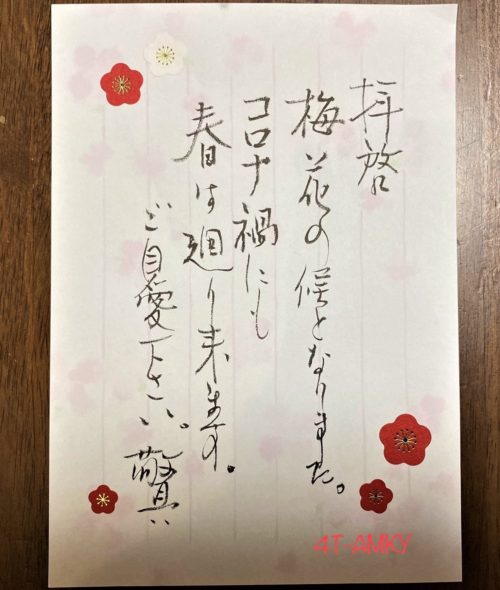When we write a letter we have a custom to preface it with some remarks about the season, called “Jiko no aisatsu” (season’s greetings) following “Haikei”(Dear ’Name’).
Japan has four distinct seasons and there are numerous fixed phrases of the “jiko no aisatsu” depending on the month.
Here are some examples:
In January
1.It has been bitterly cold.
2.The new year has come.
3.Lately, the nights have been so cold, it’s almost as if the stars have frozen.
In February
1. It is still cold, isn’t it?
2. You know spring is coming when the fragrance of ume hangs in the air.
3. Buds of Ume trees have begun to swell.
In March
1. A spring breeze is blowing.
2. Spring has just come.
3. Buds of cherry trees have begun to swell.
There are many beautiful Japanese traditions regarding letter writing. Writing about the season at the beginning of a letter like this, is one of the few that is still common in Japan.

日本には、手紙に「時候の挨拶(季節を表す言葉)」を書く習慣があります。「拝啓」に続く、書き出しの言葉です。
日本は四季が豊かな国で、月によりさまざまな慣用句があります。
例えば、
1月
1. 厳寒(げんかん)の侯
2. 初春(しょしゅん)の候
3. 星も凍るほどの寒い夜が続きます
2月
1. 余寒(よかん)の候
2. 梅香匂う(ばいかにおう)頃
3. 梅のつぼみもふくらみかけてきました
3月
1. 春風(しゅんぷう)の候
2. 早春(そうしゅん)の候
3. 桜のつぼみも膨らみはじめ
手紙についての美しい伝統が日本にはたくさんあり、このように手紙の書き始めに季節のことにふれるのも、そのひとつです。
Aki.S.
RECENT POSTS

